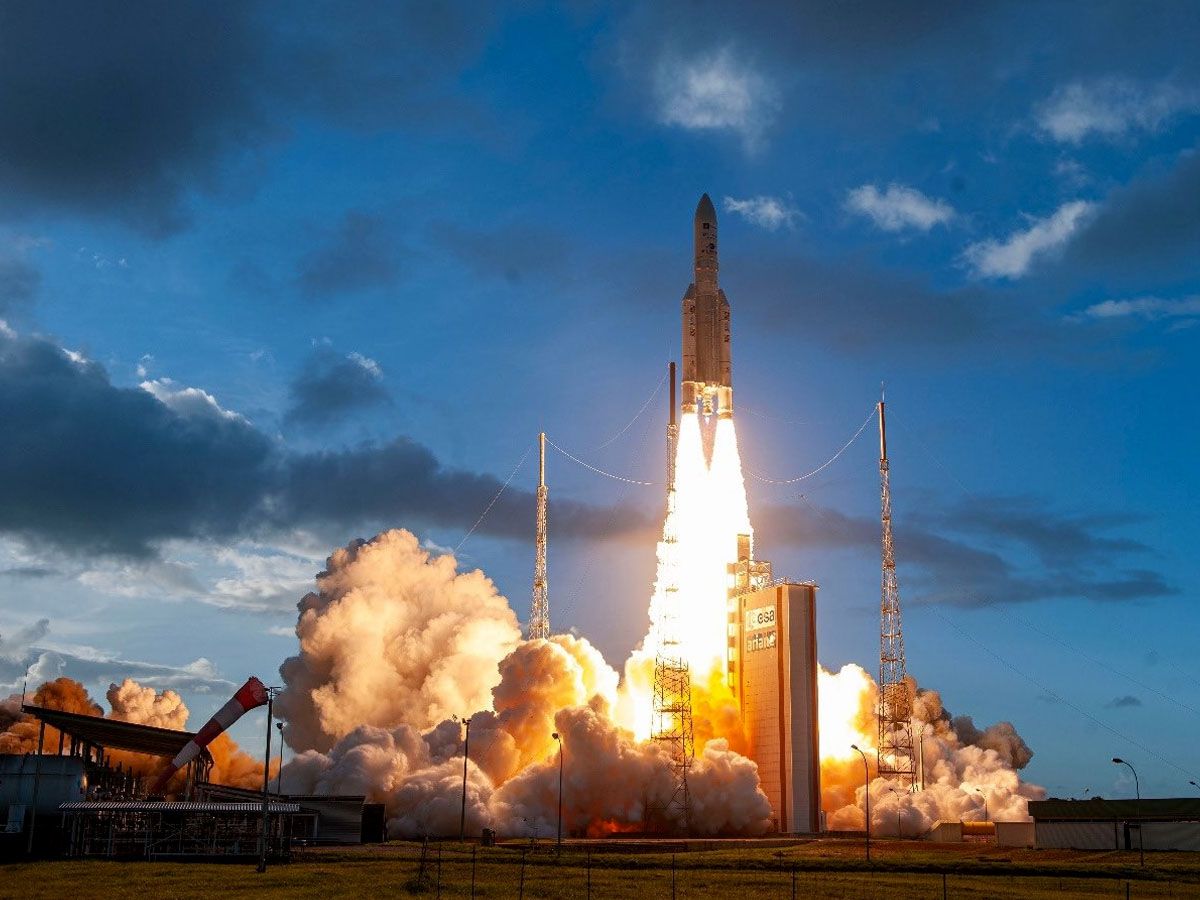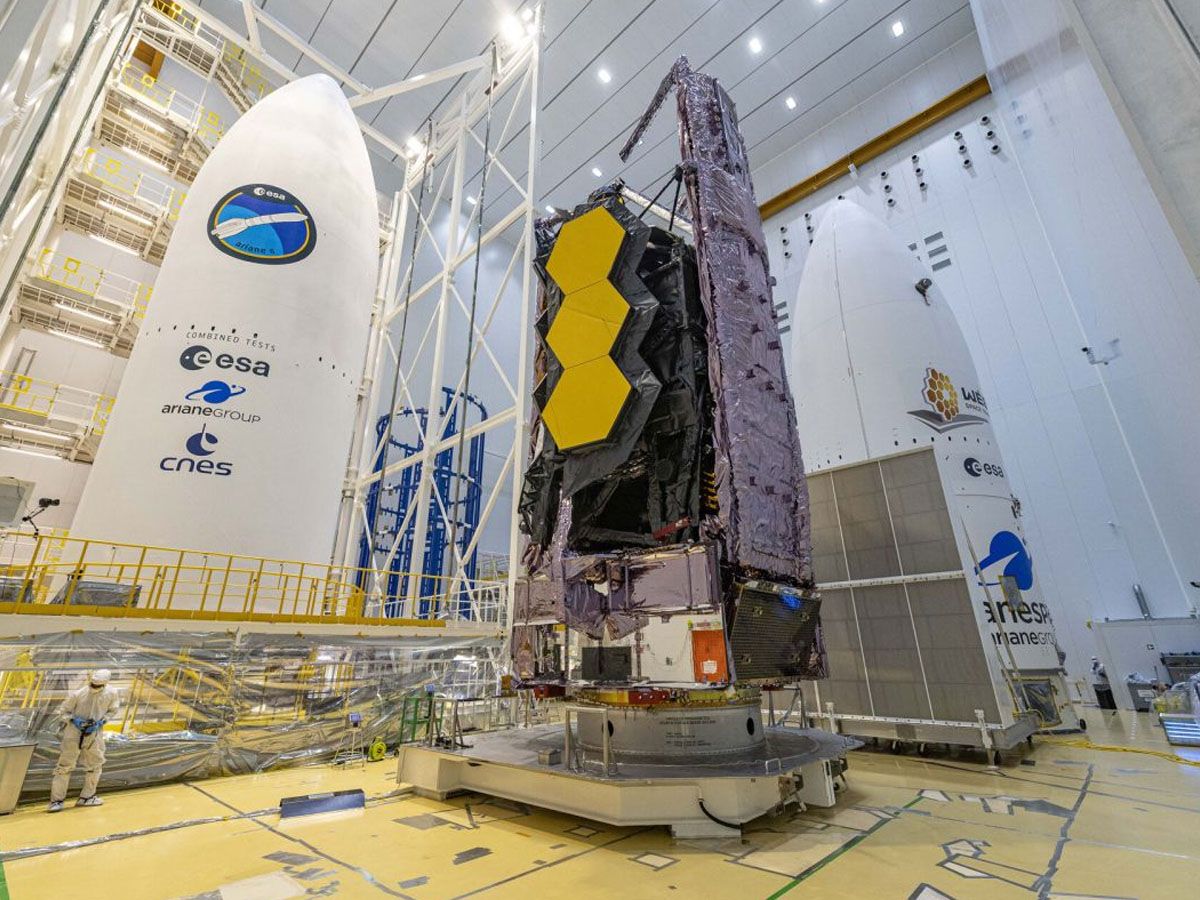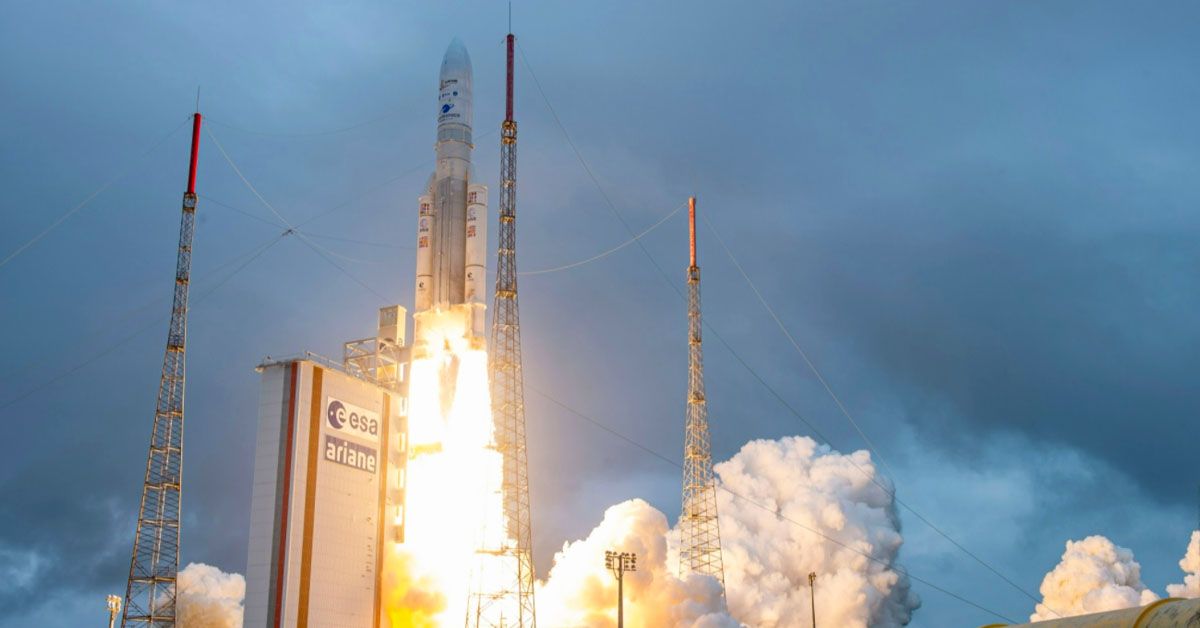The epic journey of the JWST began at the Arianespace's ELA-3 launch complex in Kourou, French Guiana, propelled by the powerful and reliable Ariane 5 rocket. But why were this specific launch location and rocket chosen, and what makes the second Lagrange point (L2) the ideal destination for this revolutionary telescope?
The Ariane 5 Rocket
A key player in the successful launch of the James Webb Space Telescope was the Ariane 5 rocket, provided by the European Space Agency (ESA) as a crucial contribution to the international partnership driving this historic mission. The Ariane 5 rocket, designed and manufactured by Arianespace, has garnered a reputation for its exceptional reliability, with over 100 successful launches under its belt.
One of the key factors behind choosing the Ariane 5 rocket was its generous fairing capacity and size, which allowed the JWST to be safely and efficiently transported into space. And the proven track record made it the ideal choice for carrying the invaluable JWST payload into orbit.

Furthermore, the selection of the Ariane 5 rocket as the launch vehicle not only demonstrated the global collaboration behind the JWST but also showcased the value that international cooperation brings to the cutting-edge world of space exploration.
Launch Location - Kourou, French Guiana
The choice of launch location played a significant role in the successful deployment of the James Webb Space Telescope. Situated near Kourou in French Guiana, Arianespace's ELA-3 launch complex boasts a strategic position in close proximity to the equator.
This geographic advantage allows the Ariane 5 rocket to capitalize on the Earth's rotational speed, which reaches its maximum at the equator, clocking in at an impressive 1670 km/hr. By launching from this location, the rocket receives an additional boost from the Earth's spin, making it easier to achieve the velocity needed to enter orbit.
This benefit not only enhances the likelihood of a successful launch but also contributes to the overall efficiency and cost-effectiveness of the mission. In essence, the Kourou launch site embodies the careful planning and strategic foresight that characterizes the extraordinary journey of the James Webb Space Telescope.
Why JWST was Sent to L2?
The decision to send the James Webb Space Telescope (JWST) to the second Lagrange point (L2) was a strategic choice, carefully considered by astronomers and engineers alike. L2 offers a unique environment that is ideal for the JWST's ambitious scientific objectives. Here are some of the main reasons behind this pivotal decision:
Stable Gravitational Environment
L2 is located approximately one million miles from Earth and is a point in space where the gravitational forces of the Earth and Sun balance each other. This creates a stable environment for the JWST to maintain its position in space, allowing it to stay aligned with the Earth as both celestial bodies orbit the Sun. This stability is essential for the telescope's long-term observations and contributes to the overall success of the mission.
Unobstructed View of the Cosmos
At L2, the JWST can enjoy a clear, unobstructed view of the cosmos without interference from Earth's atmosphere, which can distort the telescope's observations. Additionally, the JWST's position at L2 enables it to avoid the light pollution generated by human activity on Earth, which can also interfere with its ability to capture high-quality images and data.
Ideal Conditions for Infrared Observations
The JWST is primarily an infrared telescope, designed to observe the earliest galaxies, stars, and exoplanets in the universe. The cold environment of L2, combined with the stable conditions provided by the Lagrange point, allows the JWST to maintain its optimal operating temperature, ensuring the highest possible sensitivity and precision in its infrared observations.
Efficient Use of Resources
By positioning the JWST at L2, astronomers can make efficient use of the telescope's resources, such as its limited fuel supply. The stable gravitational environment at L2 enables the JWST to maintain its orbit with minimal fuel expenditure, thereby maximizing the telescope's lifespan and scientific output.
Launch Details and Configuration
The successful launch of the James Webb Space Telescope hinged on three primary components working together in harmony. First, the Ariane 5 rocket, which served as the launch vehicle, played a crucial role in propelling the JWST into space.
The second component, the payload adapter, was responsible for securing the telescope during its journey. The adapter, comprising the Cone 3936, the ACU 2624 lower cylinder, and clamp-band, provided the mechanical and electrical interface between the Webb Observatory and the Ariane 5 rocket.

The third component involved meticulous planning and execution of the launch campaign preparation and the launch campaign itself. This crucial phase was a joint responsibility shared by NASA, ESA, Northrop Grumman, and Arianespace, highlighting the collaborative efforts behind the JWST mission.
Webb Launch Configuration
To accommodate the enormous size of the James Webb Space Telescope within the Ariane 5 rocket's fairing, engineers designed the telescope to fold up compactly. This intricate folding mechanism allowed the JWST to fit within the rocket's limited space while protecting its delicate components during launch. Images provided by ArianeSpace.com demonstrate the impressive feat of engineering that enabled the JWST to fit securely inside the rocket fairing.

Challenges and Potential Single-Point Failures
The James Webb Space Telescope (JWST) is an engineering marvel, yet it faces a daunting array of challenges and potential single-point failures that could jeopardize the mission. With 344 potential single-point failures identified, each aspect of the telescope's design, deployment, and operation must be meticulously planned and executed to ensure success.
The complexity of Design and Deployment
The JWST's intricate design includes numerous moving parts, such as the telescope's sunshield, primary mirror, and solar arrays, which must deploy correctly in space after launch. These components have been painstakingly engineered and tested on the ground, but the risk of failure during deployment remains a concern. Any malfunction in the unfolding and alignment of these critical elements could severely impact the telescope's performance and compromise the mission.
Risk Mitigation Strategies
To address these potential single-point failures and other challenges, NASA and its partners have implemented rigorous risk mitigation strategies. These include extensive ground testing, stringent quality control measures, and contingency plans for various scenarios. In addition, the project's management team has closely monitored progress and made adjustments as needed to ensure that the JWST's launch and operation proceed as smoothly as possible
Deployment Timeline
Once the James Webb Space Telescope was successfully launched, it embarked on an incredible 29-day, million-mile journey to its destination: the second Lagrange point (L2). A video of the deployment procedure showcases the intricate steps involved in unfolding and positioning the telescope during its voyage. This remarkable journey highlights the precision and planning that went into ensuring the JWST's safe arrival at L2.
the James Webb Space Telescope represents a monumental achievement in human ingenuity, international collaboration, and our unyielding pursuit of knowledge. The careful selection of the Ariane 5 rocket and the strategic launch location in French Guiana exemplify the meticulous planning that has gone into every aspect of this groundbreaking mission. As the JWST takes its place at the second Lagrange point, it is poised to revolutionize our understanding of the cosmos and shed light on the mysteries of the universe's earliest days.
Sources: nasa.gov / washingtonpost.com / voanews.com












